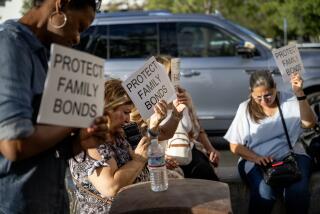A Good Job Lifts Family Values Most
- Share via
This week’s debut of the first television commercial for President George Bush’s reelection campaign confirms what some of us have feared:
Something called “family values” will be a principal issue this political year.
In the ad, an earnest-looking Bush stares into the camera and speaks: “Change must be guided by principle. . . . We must strengthen the American family. The decline of the American family is hurting the soul of America, and we’ve got to change that.”
Many--perhaps, most--would agree. Why, then, does the current discussion of “family values” in both parties’ campaigns seem so irredeemably sterile?
Watching the President, I found myself thinking--as when Bill Clinton spoke of family values during the Democratic National Convention--about some families I’ve met in the past year:
* In Brentwood Park, on Los Angeles’ affluent Westside, I encountered what politically correct people refer to these days as a “blended family.” That is, one configured from two divorces. Jim is a successful investor, Margaret a critically admired artist.
Between them, they have four children in whose schools, track meets and soccer games they are tirelessly involved. They have conservative politics and an active social conscience. They have a wide circle of acquaintances in the arts and politics, and worry about whether their children’s schools are sufficiently integrated.
* Thirty minutes east, on Sycamore Street in the mid-Wilshire district, are Menahem and Rivka. They are Muncazer Hasidim, ultra-orthodox Jews whose particular “court” was founded 200 years ago in the Carpathian Mountains of Eastern Europe.
Their third-floor walk-up apartment is in a building entirely filled with other Hasidim, and their great task is to exclude the outside world. He teaches Talmud in a nearby yeshiva, or religious school. She looks after their four obviously doted-upon children--three boys in white shirts, black vests and side curls, and a beautiful little girl of 6 in an ankle-length flowered dress.
Menahem and Rivka have no television and never go to movies. But they worry about the malevolent influence that the sights of nearby La Brea Avenue, with its trendy coffeehouses and restaurants, may have on their children.
* Another half hour east, across the Los Angeles River in Boyle Heights, lives Maria. She was born in the Aliso Village public housing project, where she still lives with her daughter, Sandra. Maria’s two older sisters have moved up and out--into marriages and good jobs in the San Gabriel Valley.
As the youngest, she stayed behind to care for their mother, who died two years ago. Four years ago, she married and five months later Sandra was born. Her husband returned to Mexico and she divorced him.
She is enrolled in a job training program and, when Sandra is old enough to start school full-time, Maria hopes that, like her oldest sister, she can get a good position with the phone company. In the meantime, she looks after her beautifully mannered, dark-eyed daughter, whose preschool art projects adorn every inch of their apartment’s tiny kitchen.
Three families. They have nothing in common but their strength, their happiness in their lives and their determination to pass on their particular values to their children. Not one requires instruction in these things from the government.
This is not to say that Washington and Sacramento have no role in the lives of this nation’s and state’s families. But it is, in fact, a limited role. There is no evidence that the families of our pluralistic democracy require instruction from their government in values. There is, however, ample support for the idea that the next administration must do more to provide families with the economic opportunity to live out the moral values of their choosing.
This is particularly clear in both political parties’ preoccupation with what has come to be called welfare dependency.
One of the most surprisingly influential documents of the current presidential campaign has been an essay titled “Social Justice in the New Century” by Sen. Daniel Patrick Moynihan (D-N.Y.). It originally appeared in the Sept. 14, 1991, issue of the Jesuit magazine America. Moynihan argues that habitual dependence on social welfare has become so deeply entrenched in many Western democracies that it constitutes a qualitatively new social problem.
As he sees it, “just as unemployment was the defining issue” among industrial democracies, “dependency is becoming the defining issue of post-industrial society.”
That may be. But as social critic Richard Rothstein pointed out in a recent essay: “The reality is, most Republican and Democratic solutions to urban poverty miss the mark. The only workable solution is a full-employment economy that provides a job with good wages for every American adult.”
There’s a pro-family sentiment fully in accord with traditional American values. And it is the one that animates one of the great classics of American social thought, Monsignor John Ryan’s landmark work of 1906, “A Living Wage.”
Ryan argued that every worker has a moral right not only to dignity in their labor, but also to a living wage. If an individual is willing to work, he insisted, society must assume “the obligation of providing him with the material means of living decently. . . . The underpaid laborer does not willingly sell his labor for less than the equivalent of a decent livelihood any more than the wayfarer willingly gives up his purse to the highwayman. It is the superior economic force (which consists essentially in the employer’s ability to wait, while the laborer must go to work today or starve) possessed by the employer that enables him to hire labor for less than a living wage. . . . (And) as a determinant of rights, economic force has no more validity or sacredness than physical force.”
In fact, those are the traditional values with which our leaders have the competence to speak to American families--if they have the courage to do so.
More to Read
Get the L.A. Times Politics newsletter
Deeply reported insights into legislation, politics and policy from Sacramento, Washington and beyond. In your inbox twice per week.
You may occasionally receive promotional content from the Los Angeles Times.










